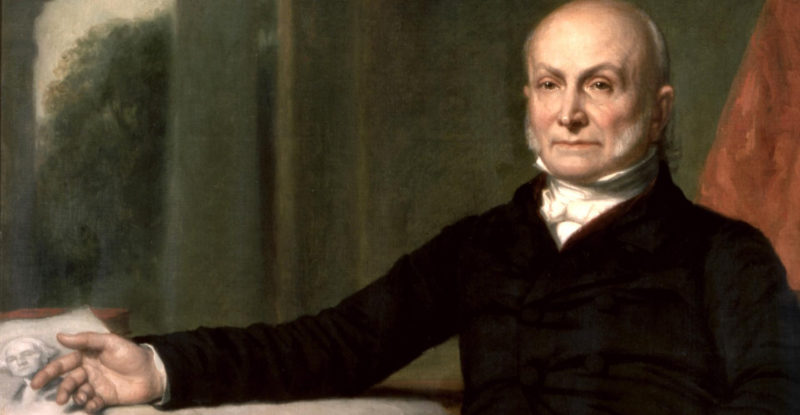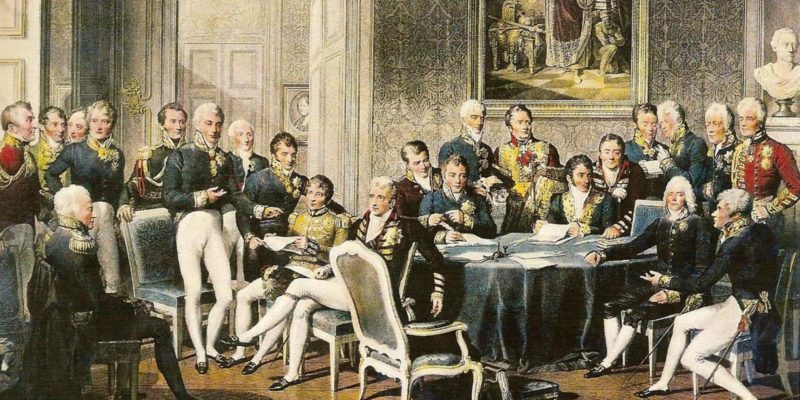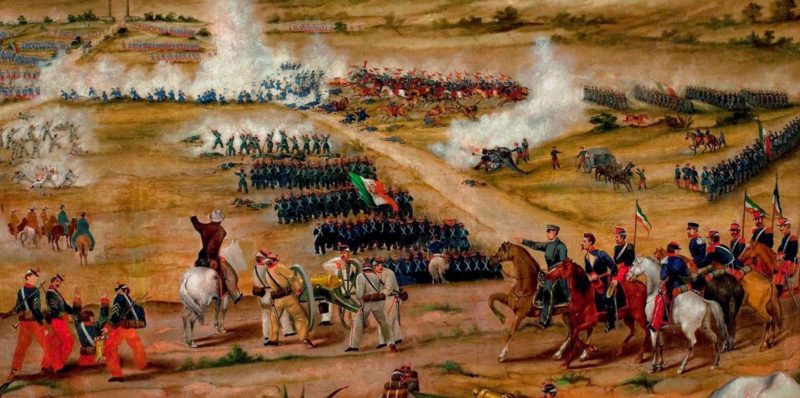We explain what the Monroe Doctrine is and what its causes and consequences are. In addition, its general characteristics, reviews and more.
What is the Monroe Doctrine?
The Monroe Doctrine was a policy adopted in 1823 by the United States , governed by President James Monroe (hence its name), with respect to the rest of the American continent and whose spirit is summed up in the phrase "America for Americans".The Monroe doctrine consisted of considering any European intervention in the destinies of the American countries as a direct offense to the United States that would merit an immediate and forceful response.
This measure had a particular impact on the international politics of the time, since it coincided with the emancipatory struggles of numerous former European colonies , confronting colonialism and imperialism directly and serving as a guarantor for the nascent Latin American republics.
Although the Monroe Doctrine was issued at a time when the United States lacked the military power to support it, it would later become important in defining international relations between the North American nation and the rest of the continent, which is why it is often considered as an announcement of the future American imperialism.
Origin of the Monroe Doctrine
 The doctrine was devised by John Quincy Adams , who would be president of the United States after Monroe, but presented by the latter to Congress in his sixth State of the Union address.
The doctrine was devised by John Quincy Adams , who would be president of the United States after Monroe, but presented by the latter to Congress in his sixth State of the Union address.The doctrine was initially met with skepticism but later with great enthusiasm, as the area of US influence in the rest of America grew. It was not called the "Monroe Doctrine" until much later.
America for Americans
 With the famous phrase " America for the Americans ", the Monroe Doctrine stipulated as a matter of strategic importance for the United States the support in the independence struggle of the rest of the continent, considering as a threat to its newly acquired sovereignty any strengthening of the United States. European imperial power in America.
With the famous phrase " America for the Americans ", the Monroe Doctrine stipulated as a matter of strategic importance for the United States the support in the independence struggle of the rest of the continent, considering as a threat to its newly acquired sovereignty any strengthening of the United States. European imperial power in America.This announcement had a double effect among Latin American intellectuals and politicians , since on the one hand they were grateful for the US support in their fight against the European powers of the Holy Alliance; but on the other, they feared from early on the interference that said resolution granted to the United States in their nascent republics .
Causes of the Monroe Doctrine
This political pronouncement was fundamentally due to the interest of the United States in protecting itself from the European presence in its vicinity, since its independent republic had finally been conquered militarily in 1783 and was militarily too weak to resist new colonial campaigns.In this sense, it was urgent to combat the European imperial alliances together with the rest of the Latin American nations that were also struggling to break with colonial dependence.
Consequences of the Monroe Doctrine
 The immediate consequences of Monroe's pronouncement were few. In Europe it did not have much repercussion , as evidenced by the European invasions that had the support or the North American neutrality in the Malvinas Islands (Great Britain occupied them in 1833), the blockade of the Argentine coasts between 1839 and 1840.
The immediate consequences of Monroe's pronouncement were few. In Europe it did not have much repercussion , as evidenced by the European invasions that had the support or the North American neutrality in the Malvinas Islands (Great Britain occupied them in 1833), the blockade of the Argentine coasts between 1839 and 1840.Then, from 1845 to 1850, the occupation of the Dominican Republic by Spain between 1861 and 1865 , the French intervention in Mexico , the British occupation of Guyana in Venezuela , etc. It cannot be said that it was much more than bravado.
In the long term, however, the doctrine would have consequences, as it was used to justify the numerous interventions of the US government in Latin America , which would last until practically the end of the 20th century . The idea that Latin America is the "backyard" of the United States is largely based on the Monroe Doctrine.
Fundamental points of the Monroe Doctrine
The application of the Monroe doctrine contemplated three central points, which were, literally:
- "The American continents (...) should no longer be considered as the object of future colonization by European powers."
- "The political system of the allied powers is essentially different (...) from that of America (...) Any attempt by them to extend their system to any portion of our hemisphere would be considered by us as dangerous to our peace and security"
- “In the wars between European powers for their own reasons we have never taken any part, nor is it in our policy that we take it”
Rutherford Hayes Corollary
In 1880, a first corollary was added to the Monroe Doctrine, which considered the Caribbean and Central America as part of the "exclusive sphere of influence" of the United States. This was stated by then President Hayes, adding to the Monroe Doctrine that in order to avoid the interference of European imperialism in America, his nation should exercise exclusive control of any interoceanic canal that was built.This is how, later, the United States would feel legitimate to legally take over the Panama Canal , whose construction had been abandoned in 1888. Furthermore, with this corollary, the United States prevented Europe's commercial access to the Caribbean and Central America , maintaining its trade monopoly with these regions.
Roosevelt Corollary
 Another corollary of the doctrine was issued in 1904 by the then American president Theodore Roosevelt , as a result of the naval blockade that Venezuela suffered between 1902 and 1903 by the British , German and Italian Empires , demanding the immediate payment of debts contracted. by the government of the then president of the South American nation Cipriano Castro.
Another corollary of the doctrine was issued in 1904 by the then American president Theodore Roosevelt , as a result of the naval blockade that Venezuela suffered between 1902 and 1903 by the British , German and Italian Empires , demanding the immediate payment of debts contracted. by the government of the then president of the South American nation Cipriano Castro.In said blockade, the United States acted as an impartial mediator, and then announced the corollary to the Monroe Doctrine in which they established the right of their nation to freely intervene in the rest of the American countries , to reorder the State or return the guarantees of operation to their companies and interests in said nation, in the event of an intervention by powers outside the continent that would put them at risk.
With this controversial corollary, the US itself gave itself permission to dispose of other countries by violating their sovereignty and self-management . This meant a new stage of US imperialism called "The Big Stick" in which the use of force was a common card in US relations with the rest of the continent.
The Diaz Doctrine
 The Díaz doctrine was pronounced by the then Mexican president, Porfirio Díaz , as a response to the last corollary of the Monroe doctrine . It stated that all peoples should be free to self-determine their future and self-govern, without another nation having the right to intervene in it, nor recognize or ignore said government .
The Díaz doctrine was pronounced by the then Mexican president, Porfirio Díaz , as a response to the last corollary of the Monroe doctrine . It stated that all peoples should be free to self-determine their future and self-govern, without another nation having the right to intervene in it, nor recognize or ignore said government .
Criticism of the Monroe Doctrine
The Monroe Doctrine has been widely criticized as a document that simply gives the US the power to make the American continent its political administration , something that was demonstrated by the lack of US intervention in the European invasions that followed its proclamation.The final criterion had more to do with the European powers that were enemies of the US than really with some kind of American alliance for independence. “America for Americans”, according to its detractors, should be interpreted as “America for Americans” .
Contradictions to the Monroe Doctrine
So convenient were the statements of this doctrine that the US itself contravened it on several occasions , as occurred during the support of the British government during the Falklands War disputed against Argentina in 1982, to cite an example.The above content published at Collaborative Research Group is for informational and educational purposes only and has been developed by referring reliable sources and recommendations from technology experts. We do not have any contact with official entities nor do we intend to replace the information that they emit.
Passionate about understanding and contributing to a world that does not stop changing. New forms of Work, Sustainability and Technology. For many years he has worked as a creative for large international companies. He has a Ph.D. in information technology and he has been doing quantitative research in the interdisciplinary areas of information systems, cyber security, data analytics and artificial intelligence. He continue to look for creative solutions through technology to help companies to be more humane and sustainable..
Leave a reply
Your email address will not be published. Required fields are marked *Recent post

Sport: What Is It, Types, Risks, Features, Characteristics and Examples
September 23, 2021

Dogs: Emergence, Features, Characteristics, Feeding and Breeds
September 24, 2021

Story: Definition, Elements, Structure, Features and Characteristics
September 24, 2021

Essay: Definition, Structure, Features, Characteristics, How to Do It
September 24, 2021
